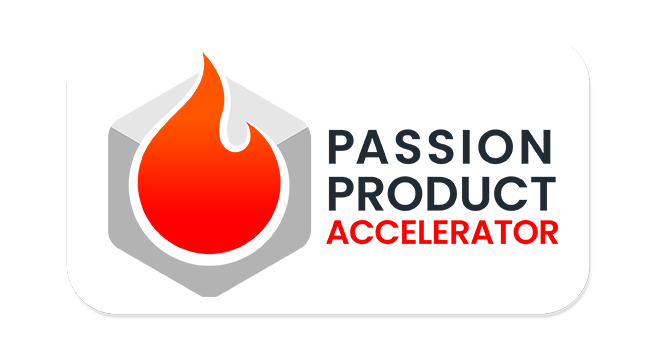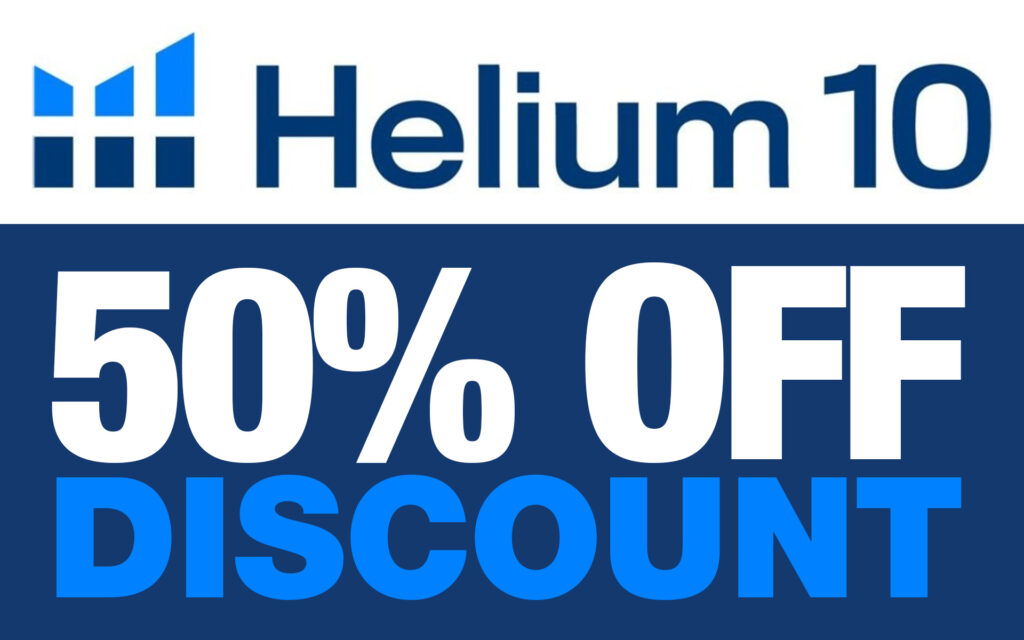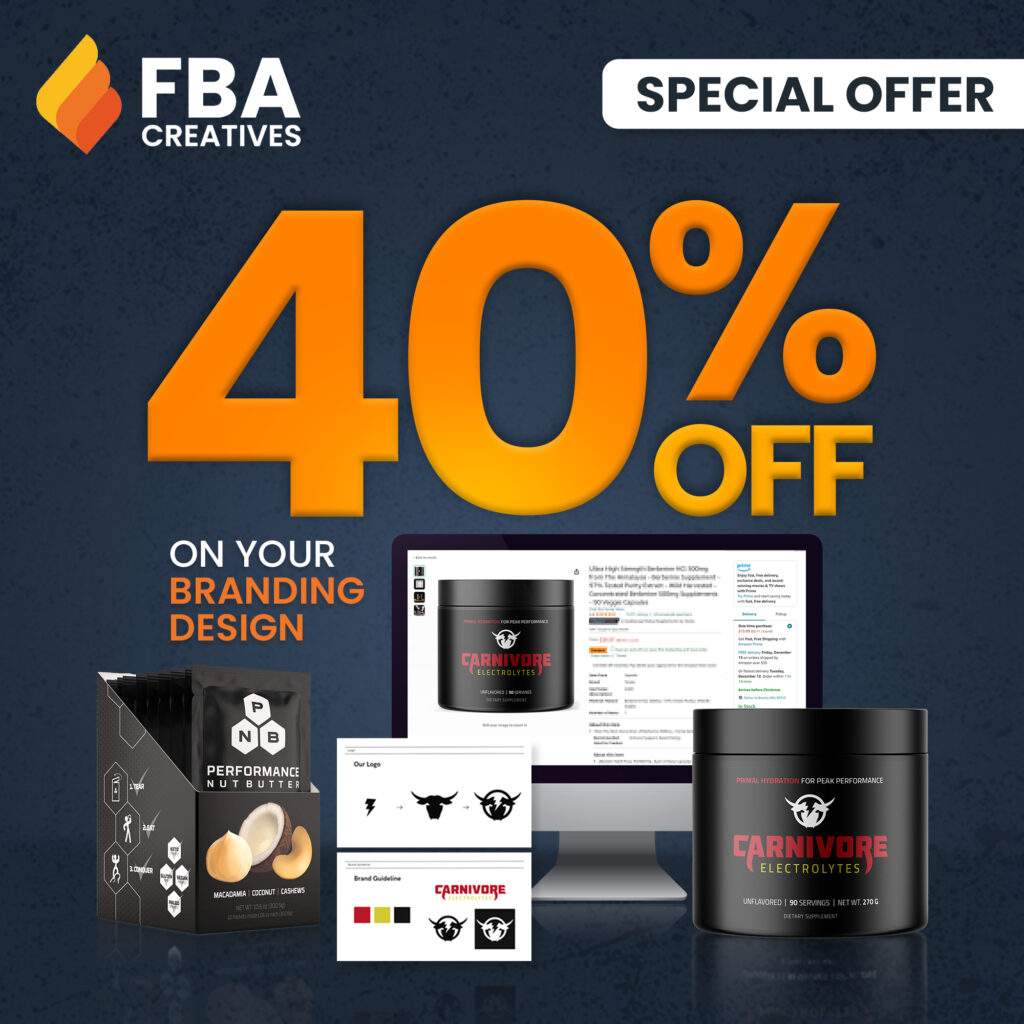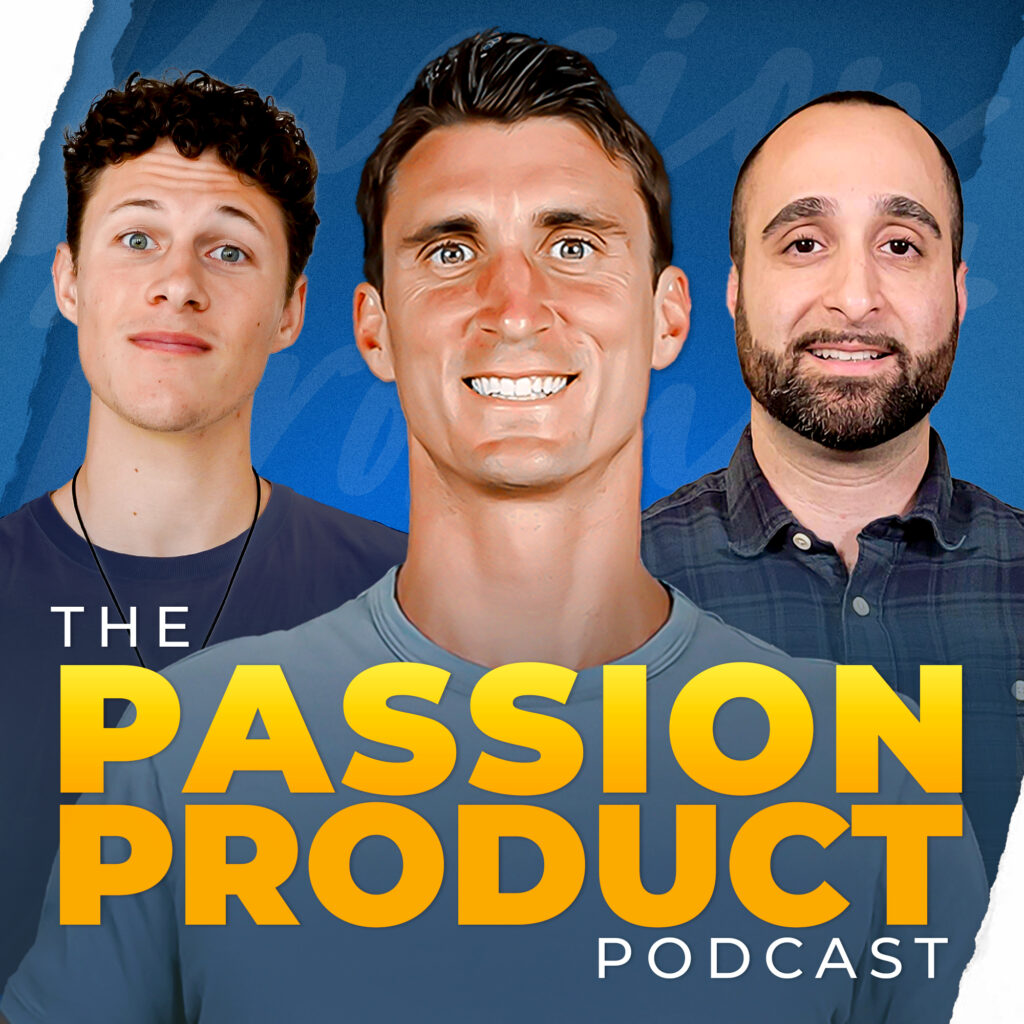Finding the right manufacturer for your Amazon FBA product doesn’t have to take weeks or months. You can identify reliable suppliers quickly using four proven methods. First, Alibaba connects you with manufacturers across China, India, Vietnam, and Southeast Asia. Simply search your product, apply Trade Assurance and Verified Manufacturer filters, then evaluate suppliers based on years in business and customer reviews. Always request custom samples before committing to orders. Second, ThomasNet specializes in American manufacturers, which is absolutely essential for consumable products requiring FDA compliance. While domestic manufacturing costs more, you gain quality assurance, easier communication, and valuable “Made in America” marketing advantages. Remember to create a comparison spreadsheet tracking minimum order quantities, pricing, lead times, and communication quality for all potential suppliers you contact.
Beyond marketplace platforms, Google search offers a surprisingly effective yet underutilized sourcing strategy. Simply type your product name plus “manufacturer” to discover suppliers not actively marketing on Alibaba or ThomasNet. This direct approach eliminates platform fees and often reveals specialized manufacturers offering unique capabilities. The fourth and most powerful method involves accessing pre-vetted manufacturer databases through the Passion Product Formula. This comprehensive training program provides over 100 tutorials, weekly Q&A sessions with successful sellers, and one-on-one coaching. Most valuable is the exclusive spreadsheet containing every manufacturer experienced sellers have successfully worked with, eliminating trial-and-error. Even better, a free 10-hour YouTube training offers tremendous value for those wanting to start learning immediately without financial commitment.
Take action today by defining your product specifications clearly, then searching across all platforms to compile potential manufacturers. Contact at least ten candidates and request samples from your top three choices before making final decisions. Remember that every successful Amazon seller started exactly where you are now, the difference lies in taking consistent action despite uncertainty. Whether you join the Passion Product Formula for comprehensive support or start with free resources, begin your manufacturer search immediately. The suppliers you need are ready and waiting to partner with entrepreneurs who have great ideas and determination to succeed. Your profitable Amazon FBA business starts with the single step you take right now toward finding your ideal manufacturing partner.

- Why Finding the Right Manufacturer Matters
- Method #1: Alibaba – The Global Marketplace Powerhouse
- Method #2: ThomasNet – The American Manufacturing Solution
- Method #3: Google Search – The Obvious Solution Everyone Overlooks
- Method #4 (BONUS): The Insider's Secret – Proven Manufacturer Database
- Pro Tips for Working with Manufacturers
- Your Next Steps: Taking Action Today
- Turning Knowledge Into Results
- Frequently Asked Questions
Why Finding the Right Manufacturer Matters

Quality and Pricing Impact
Choosing the right manufacturing partner fundamentally shapes your entire Amazon FBA business trajectory. Notably, your manufacturer directly impacts product quality. Subsequently, this determines your customer reviews, return rates, and overall brand reputation on the platform. Furthermore, pricing negotiations with your supplier affect your profit margins. Simultaneously, they also affect your competitive positioning. Therefore, this makes the decision critical to your financial success.
Reliability and Long-Term Growth
Beyond quality and pricing, reliability proves essential for maintaining consistent inventory levels. Additionally, it helps you meet customer demand effectively. A dependable manufacturer ensures you can restock efficiently. Moreover, you can avoid dreaded stockouts. Consequently, you can capitalize on momentum when your product gains traction. Additionally, the right partnership creates opportunities for long-term growth. Furthermore, it enables product line expansion. Ultimately, it facilitates collaborative innovation that can differentiate your brand in crowded marketplaces.
Making Informed Decisions
Consequently, investing time upfront to find the ideal manufacturer pays dividends throughout your entire seller journey. The methods outlined below will help you identify partners who align with your vision. Furthermore, they’ll meet your specifications. In addition, they’ll support your ambitions. Most importantly, these strategies enable you to make informed decisions quickly. Remarkably, you won’t sacrifice thoroughness or due diligence.
Now that you understand the stakes involved in manufacturer selection, let’s explore the first method. Notably, it’s the most popular method for sourcing your products worldwide.
Method #1: Alibaba – The Global Marketplace Powerhouse
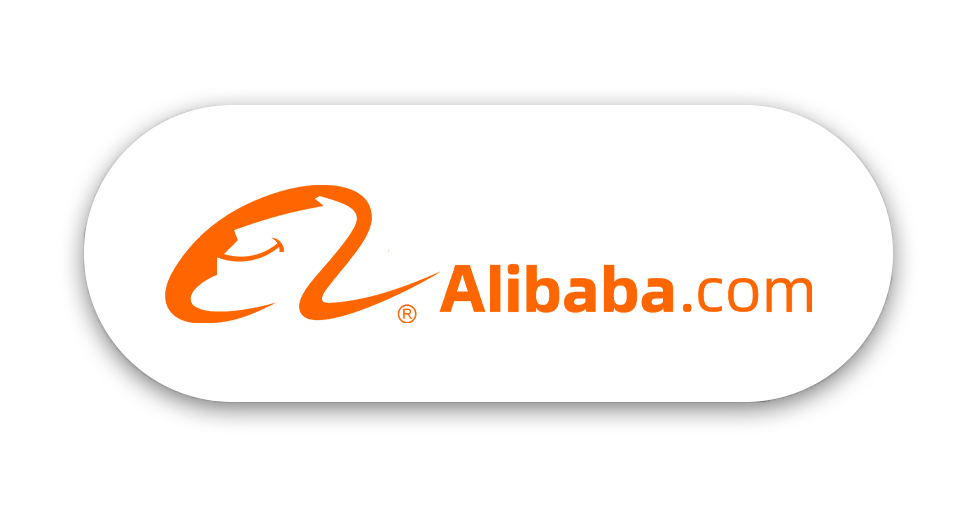
Introduction to Alibaba
Alibaba stands as the undisputed champion of global product sourcing. Specifically, it connects millions of buyers with manufacturers across the world. This massive online marketplace primarily features suppliers from China. However, you’ll also discover excellent options from India, Vietnam, and throughout Southeast Asia. Remarkably, the platform’s versatility is truly remarkable. Manufacturers on Alibaba can produce virtually anything you can imagine. This ranges from simple accessories to complex electronic devices.
What makes Alibaba particularly valuable for Amazon FBA sellers is its accessibility. Furthermore, the user-friendly interface is another major advantage. Notably, you don’t need special connections or industry experience. Instead, you can access thousands of qualified manufacturers instantly. Simply search for your product. Subsequently, you instantly gain access to a global network of suppliers. These suppliers are eager to work with entrepreneurs like you. Consequently, this democratization of manufacturing access has transformed the Amazon FBA landscape. Ultimately, it enables anyone with a great product idea to bring it to life.
Getting Started on Alibaba
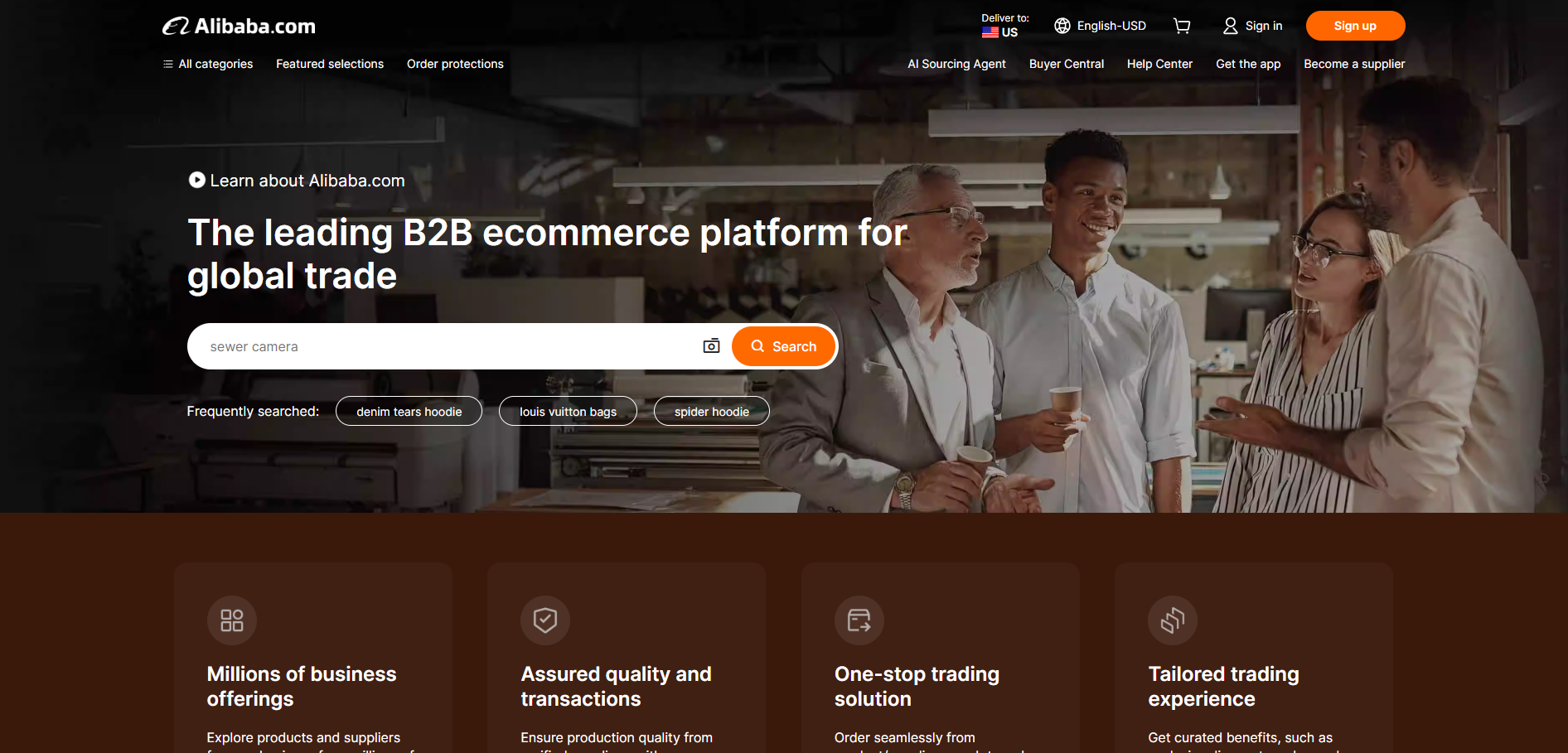
Starting your Alibaba search follows a remarkably simple process. Additionally, it mirrors the familiar experience of shopping on Amazon. First, navigate to Alibaba.com. Then, type your product name into the search bar. For instance, if you’re sourcing golf tees, simply enter “golf tee” and hit search. Immediately, the platform generates a comprehensive list of manufacturers. These manufacturers produce your desired product. Moreover, you’ll see photos, specifications, and pricing information.
Essential Filters and Selection Criteria
However, before you dive into contacting suppliers, you must apply two critical filters. Importantly, these filters separate legitimate manufacturers from potential problems. First, activate the “Trade Assurance” filter. Essentially, this provides buyer protection if anything goes wrong during your transaction. Specifically, Alibaba guarantees your money back if issues arise. Second, select only “Verified Manufacturer” suppliers. This means Alibaba has physically sent representatives to confirm these companies. Therefore, they verify that these companies actually operate legitimate factories. Consequently, they’re not middlemen who source from questionable channels.
Once you’ve applied these essential filters, additional evaluation criteria help narrow your choices further. Importantly, pay close attention to how long each supplier has been in business. Generally, longevity indicates stability and reliability. Ideally, you want manufacturers with five to ten years of experience or more. Similarly, review ratings provide valuable insights. Specifically, they show communication quality, product accuracy, and overall reliability. Therefore, target suppliers maintaining four to five-star averages.
Nevertheless, don’t automatically dismiss newer manufacturers. Often, they offer compelling advantages. These include lower minimum order quantities and more competitive pricing. Additionally, these emerging suppliers may be hungry for business. Furthermore, they’re often willing to accommodate smaller initial orders. Consequently, this can benefit sellers testing product viability. Therefore, you’ll need to balance experience with flexibility. Base this on your specific situation and risk tolerance.
Understanding Customization Capabilities
Finding manufacturers who produce generic versions of your product represents just the starting point. However, the real challenge involves identifying suppliers with capabilities to handle your specific customization requirements. For example, when sourcing the Bogeys and Beers golf tees, the search revealed numerous golf tee manufacturers on Alibaba. Nevertheless, the critical question became different. Which suppliers could print 26-character custom messages in green ink on yellow tees? Furthermore, could they do this across 18 different designs?
Surprisingly, only about 15% of contacted suppliers possessed the necessary capabilities. Specifically, they needed the equipment, expertise, and willingness to handle these specific requirements. Consequently, this reality underscores an important lesson. Clearly, you must clearly communicate your customization needs upfront. Therefore, don’t assume any manufacturer producing similar products can accommodate your vision. Instead, create detailed specification documents. Include colors, materials, printing requirements, and packaging needs. Additionally, include any other unique elements that differentiate your product.
Additionally, request samples that demonstrate the supplier’s actual capabilities. Specifically, these should include your specific customizations. Instead, don’t rely solely on their existing product portfolio. This approach reveals whether they truly understand your requirements. Furthermore, it shows whether they can execute them consistently at scale. Moreover, sample review helps you identify potential issues. Ultimately, you can catch these before committing to large production runs. Consequently, this saves substantial time and money.
Critical Questions for Suppliers

Effective communication with potential manufacturers requires asking strategic questions. Importantly, these questions reveal critical information for your decision-making process. First, inquire about lead time. Essentially, this is the duration from when you submit payment until the completed products are ready for shipment. Understanding lead times proves essential for planning your launch timeline. Therefore, it ensures you can meet your target dates. Consequently, you won’t face rushing or delays.
Second, clarify the minimum order quantity (MOQ). Specifically, this specifies the smallest number of units the manufacturer will produce. MOQs vary dramatically between suppliers. Typically, they range from a few hundred units to tens of thousands. Notably, this significantly impacts your initial investment and inventory risk. Furthermore, ask whether they offer samples. Additionally, find out what those samples cost. Most reputable manufacturers provide samples. However, pricing structures differ based on customization complexity.
Third, verify whether they can produce custom samples. Specifically, these should incorporate your specific requirements. Instead, don’t settle for existing stock items. Custom samples provide infinitely more value. Particularly, they demonstrate the supplier’s actual ability to execute your vision. Additionally, discuss pricing at various quantity levels. Generally, per-unit costs typically decrease substantially as order volumes increase. Therefore, this affects your profit margin calculations and growth strategy.
Important Note About Consumable Products
While Alibaba excels for sourcing most product categories, one critical exception demands your attention. Specifically, that exception is consumable products. If you’re developing anything that customers will eat, drink, or consume internally, strongly consider avoiding overseas manufacturers. Instead, favor US-based alternatives. This recommendation stems from safety concerns. Additionally, it stems from certification requirements and liability issues. Consequently, these factors make domestic manufacturing far more suitable for consumables.
American manufacturers typically maintain certifications. Furthermore, they follow FDA regulations. Additionally, they adhere to safety standards that provide credibility and legal protection for your business. Moreover, if quality issues arise with consumable products, the consequences can be severe. These range from customer health problems to legal liability. Ultimately, they can result in permanent brand damage. Consequently, the premium you pay for domestic manufacturing of consumables represents insurance. Therefore, it provides peace of mind that’s absolutely worth the investment.
The good news is that our second method specifically addresses this issue. Specifically, it shows you how to find excellent American manufacturers for these types of products. Therefore, if your product falls into the consumable category, pay close attention to the next section. Subsequently, we’ll explore ThomasNet and domestic sourcing options.
Method #2: ThomasNet – The American Manufacturing Solution
Platform Overview
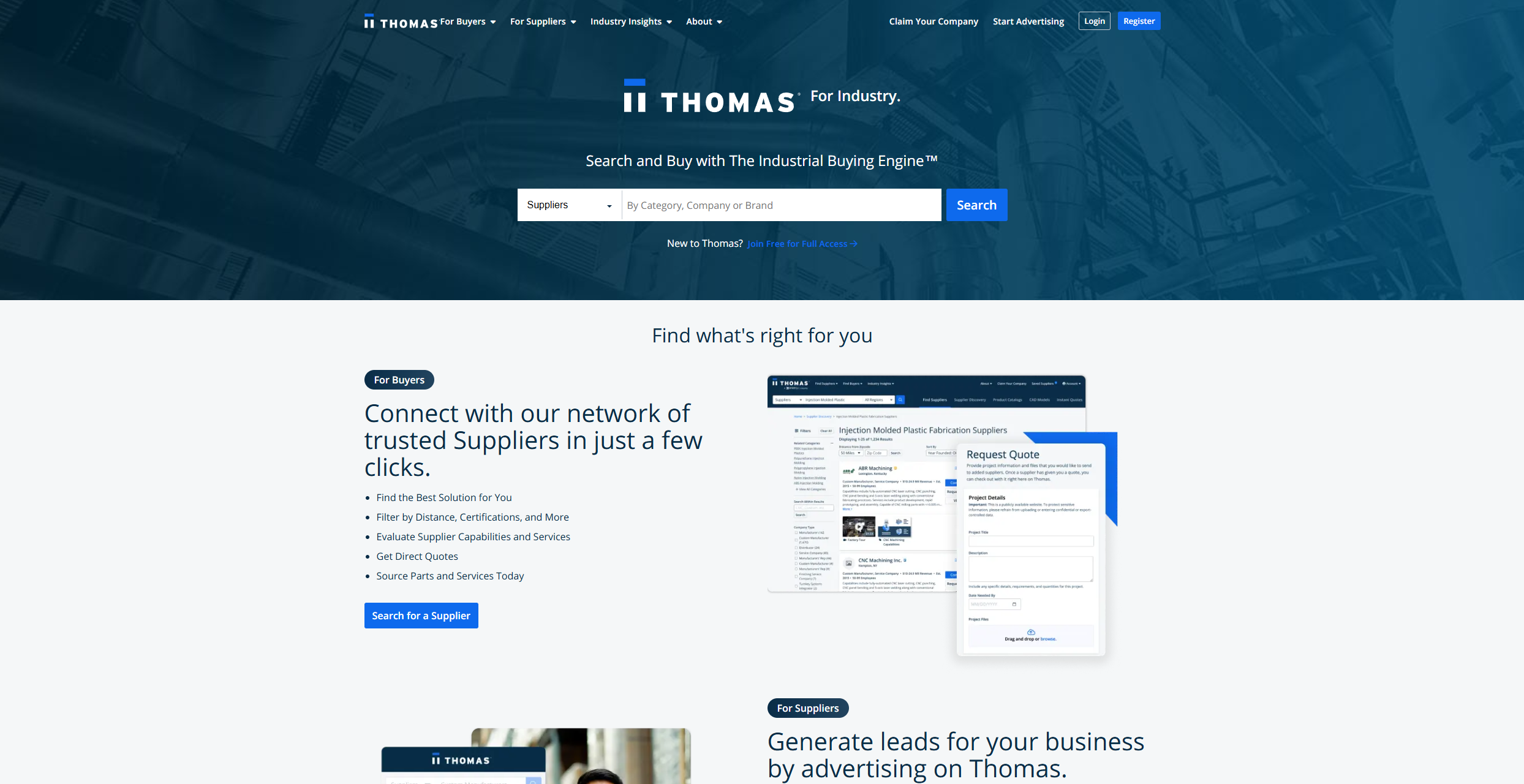
ThomasNet serves as the premier platform for connecting with manufacturers throughout the United States. Specifically, it offers a domestic alternative to Alibaba’s international focus. When you visit ThomasNet.com, you’ll immediately notice something familiar. Notably, the interface resembles Alibaba’s familiar layout. Consequently, this makes navigation intuitive even for first-time users. Simply enter your product name in the search bar. Subsequently, the platform generates a comprehensive list of American suppliers. These suppliers are ready to bring your vision to life.
This platform particularly shines when you need the quality assurance that comes with American manufacturing. Additionally, you also get certifications and credibility. The suppliers listed on ThomasNet operate facilities across the United States. Therefore, this provides transparency and accessibility. Sometimes, international suppliers cannot match this. Furthermore, working with domestic manufacturers often simplifies communication. This happens due to shared time zones, language, and business practices. Consequently, this streamlines your product development process significantly.
Best Use Cases for ThomasNet
ThomasNet becomes absolutely essential when developing consumable products. Specifically, anything customers will eat or drink must be manufactured domestically. Consequently, this ensures proper safety standards and certifications. Food and beverage items require FDA compliance. Additionally, they need health inspections. Furthermore, they require rigorous quality controls that American manufacturers routinely maintain. These are part of their standard operations. Therefore, these products simply aren’t suitable for overseas manufacturing. This applies regardless of cost savings.
Beyond consumables, ThomasNet proves valuable for other reasons. Particularly, it’s useful when you want to leverage “Made in America” as a marketing advantage. Many consumers actively seek domestically manufactured products. Moreover, they willingly pay premium prices for them. This particularly applies in categories where quality and safety matter most. Additionally, certain product certifications and testing requirements are easier to obtain. This happens through American manufacturers who already maintain relevant accreditations. Furthermore, they understand domestic regulatory landscapes.
The platform also excels when you need smaller production runs. Additionally, it’s great when you need more hands-on collaboration during product development. American manufacturers often demonstrate greater flexibility. Specifically, they’re better with customization, prototyping, and iterative refinement. This differs from overseas suppliers focused on high-volume production. Moreover, visiting facilities in person becomes feasible. This happens when your manufacturer operates domestically. Consequently, it enables relationship-building and quality oversight. Distance makes this difficult with overseas suppliers.
Navigation and Cost Considerations
Searching ThomasNet follows the same straightforward process as Alibaba. Simply type your product name and review the results. For instance, searching “golf tee” on ThomasNet yields 61 suppliers. Therefore, this provides numerous options for domestic sourcing. However, you’ll quickly notice something important. Typically, pricing from American manufacturers runs higher. This is compared to comparable quotes from Chinese or Southeast Asian suppliers. Sometimes it’s significantly higher.
This premium reflects higher labor costs. Additionally, it reflects stricter regulatory compliance. Furthermore, it reflects different operational structures in the United States. Nevertheless, the increased cost often delivers corresponding value. This comes through superior quality control. Moreover, you get faster communication. Additionally, you get easier logistics. Furthermore, you get the credibility that comes with American manufacturing. Therefore, you must evaluate whether these benefits justify the higher price point. Consider your specific product and target market.
As you scroll through manufacturer options, maintain the same diligent vetting process. Specifically, use the same process described for Alibaba. Create your comparison spreadsheet. Subsequently, track essential information like company longevity, capabilities, and minimum order quantities. Include sample pricing and lead times. This systematic approach enables informed decision-making. Consequently, it ensures you’re comparing suppliers fairly across multiple dimensions. Ultimately, you won’t focus solely on price.
Method #3: Google Search – The Obvious Solution Everyone Overlooks

Simple Yet Powerful Strategy
Sometimes the best solutions hide in plain sight. Notably, Google search represents one of the most underutilized yet effective manufacturer sourcing strategies available. The process couldn’t be simpler. Type your product name followed by the word “manufacturer” into Google’s search bar. Instantly, you’ll receive a list of potential suppliers. For example, searching “golf tee manufacturer” reveals companies specializing in exactly what you need. Often, this includes options you won’t find on marketplace platforms.
This straightforward approach provides direct access to manufacturer websites. Consequently, it enables you to learn about their capabilities. Moreover, you can view their portfolios. Additionally, you can understand their specializations without platform intermediaries. Furthermore, Google searches frequently surface smaller or more specialized manufacturers. These companies don’t actively market on Alibaba or ThomasNet. However, they offer exceptional quality and service. Ultimately, these hidden gems can become your competitive advantage. This particularly applies if you’re seeking unique capabilities or niche expertise.
Key Benefits of Direct Search

Google search offers several distinct advantages over platform-based sourcing. Consequently, these advantages make it worth including in your strategy. First, you avoid marketplace fees. Furthermore, you connect directly with manufacturers. Therefore, this potentially secures better pricing since no platform takes a commission. Second, direct communication through company websites often leads to faster responses. Additionally, you often get more personalized service. This compares favorably to managing relationships through third-party platforms.
Additionally, Google searches help you discover local and regional manufacturers. Often, these may offer proximity advantages. These include easier facility visits, reduced shipping costs, and supporting your local economy. Moreover, you’ll also find highly specialized manufacturers. Typically, they focus exclusively on specific product types or materials. Consequently, they bring deep expertise that generalist suppliers cannot match. Furthermore, using Google allows you to research companies thoroughly. Specifically, you can read their history. Additionally, you can view customer testimonials. Moreover, you can understand their values and business philosophy.
The flexibility of Google search also enables creative query variations. Consequently, these uncover different supplier types. For instance, you might search for “custom product manufacturer.” Alternatively, you could try “product name wholesale supplier.” Similarly, try “product name private label.” Essentially, this accesses different segments of the manufacturing landscape. Consequently, this method complements platform searches. Ultimately, it fills gaps and provides alternatives. These might perfectly suit your needs.
Combining Multiple Approaches
Rather than choosing one sourcing method exclusively, successful Amazon sellers strategically combine multiple approaches. Consequently, this maximizes their options and negotiating leverage. Use Google to supplement your Alibaba and ThomasNet findings. Therefore, create a comprehensive list that includes both marketplace-featured suppliers and independent manufacturers. This diversification ensures you’re not missing excellent partners. Sometimes, they simply don’t maintain active platform presences.
Furthermore, Google search enables you to cross-reference suppliers. This works for suppliers found on other platforms. If an Alibaba supplier looks promising, Google their company name. Subsequently, you can find additional information. Moreover, you can find reviews from other buyers. Additionally, you can verify their legitimacy. This due diligence step helps you avoid fraudulent operators. Furthermore, it helps identify any red flags. These might not be apparent from marketplace profiles alone. Ultimately, combining these methods creates a robust sourcing strategy. Consequently, it leverages the strengths of each approach. Simultaneously, it compensates for their individual limitations.
Method #4 (BONUS): The Insider’s Secret – Proven Manufacturer Database
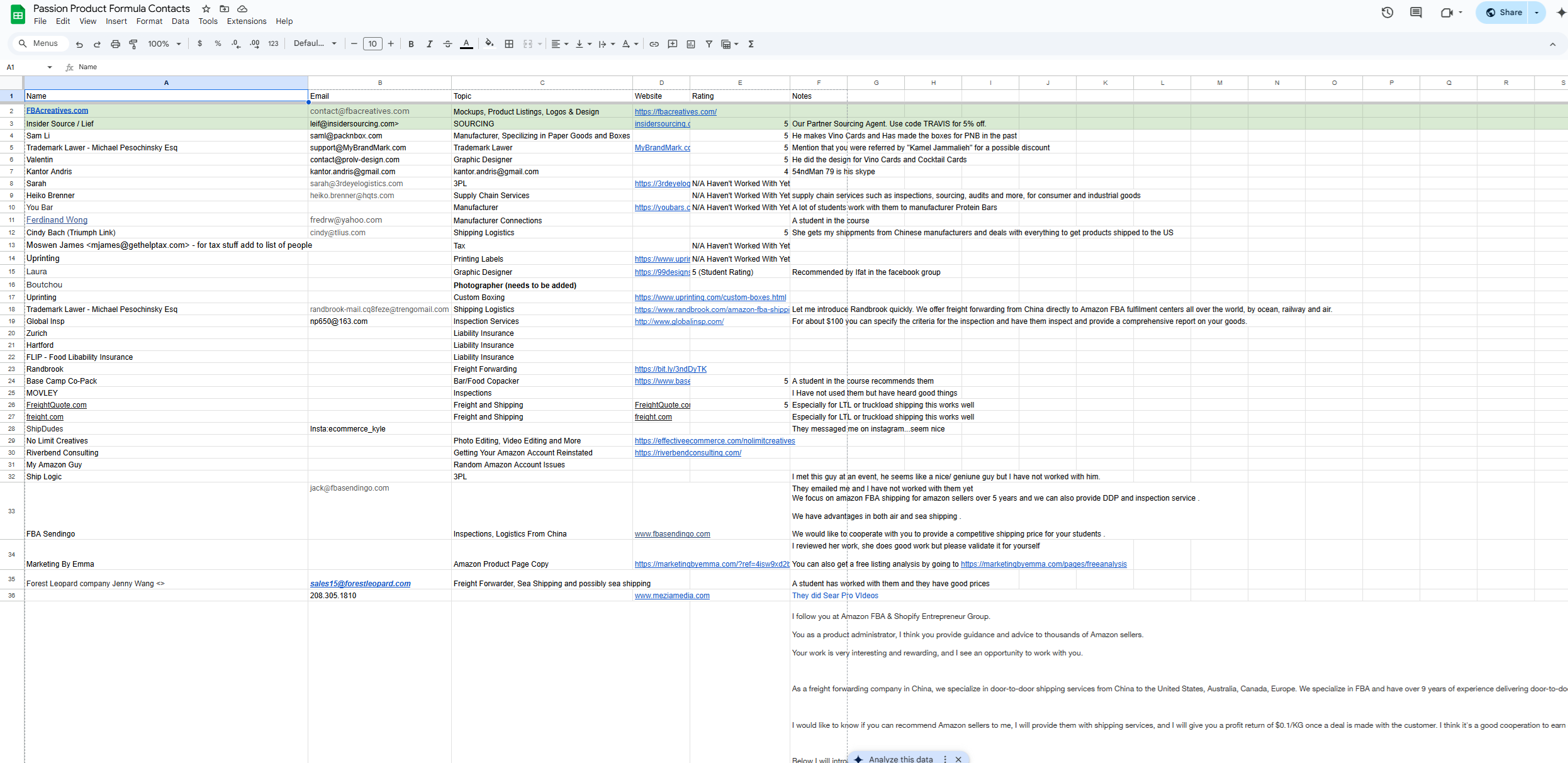
Exclusive Access to Vetted Suppliers
Now we arrive at the most powerful sourcing method available. Notably, this one dramatically accelerates your manufacturer selection process. Simultaneously, it reduces risk substantially. Imagine having access to a comprehensive spreadsheet. Specifically, it contains every manufacturer that experienced Amazon sellers have successfully worked with. This represents years of business relationships. Consequently, this resource eliminates the guesswork and trial-and-error phase. Furthermore, it connects you directly with suppliers who have already proven their reliability. Additionally, they’ve proven their quality and trustworthiness through real-world partnerships.
This exclusive manufacturer database represents years of relationship-building. Moreover, it represents years of testing and vetting condensed into one invaluable resource. Instead of wondering whether a supplier will actually deliver on their promises, you gain instant access. Specifically, you get manufacturers who have consistently met expectations for other successful sellers. Moreover, these pre-vetted relationships often lead to smoother negotiations. Additionally, they lead to better terms. The manufacturers appreciate referrals from satisfied partners. Furthermore, they want to maintain their reputation.
The value of this insider access cannot be overstated. Essentially, it’s the difference between spending months researching suppliers and potentially making costly mistakes. With this access, you immediately connect with manufacturers who can execute your vision flawlessly. Furthermore, this resource continues growing and improving. More sellers contribute their experiences and discoveries. Consequently, this creates a continuously expanding network of reliable manufacturing partners. Ultimately, you benefit from collective wisdom. Therefore, you don’t learn everything through personal trial and error.
Comprehensive Training Program

This extraordinary manufacturer database forms just one component of a comprehensive training program. Specifically, the program guides you through every step of launching a successful Amazon FBA business. The Passion Product Formula provides over 100 detailed tutorials. These cover everything from initial product ideation through successful Amazon launch and scaling. Consequently, this systematic approach ensures you don’t miss critical steps. Moreover, you won’t make preventable mistakes that derail many new sellers.
Beyond the tutorials, the program offers weekly Q&A sessions. Notably, these sessions feature experienced Amazon sellers. Specifically, they’ve navigated the challenges you’re facing. Furthermore, they’ve achieved meaningful success. These live interactions provide personalized guidance. Additionally, they answer your specific questions. Moreover, they offer accountability that keeps you moving forward. This happens even when obstacles arise. Additionally, you receive two one-on-one coaching sessions. Therefore, you can dive deep into your unique situation. Consequently, you receive tailored strategies for your specific product and market.
The Passion Product Formula stands out because it combines proven systems with ongoing support. Consequently, this creates an environment where success becomes not just possible but probable. Instead of piecing together information from countless YouTube videos and blog posts, you follow a tested roadmap. Notably, this roadmap has helped numerous sellers build profitable Amazon businesses. Moreover, the community aspect connects you with fellow entrepreneurs. Specifically, they’re on similar journeys. Consequently, this provides motivation, collaboration opportunities, and friendship. Ultimately, you get these alongside business growth.
Free Resources to Get Started
For those not quite ready to commit to the full program, there’s good news. Specifically, a completely free 10-hour YouTube training video is available. It covers the essential steps for creating your Amazon FBA passion product. This extensive free resource provides tremendous value. Moreover, it allows you to experience the teaching style and approach. Additionally, you can do this before making any investment. Therefore, you can start learning immediately. This applies regardless of your current budget or readiness level. Consequently, you can take meaningful steps toward your Amazon seller goals today.
Pro Tips for Working with Manufacturers

Building Your Comparison System
Organization becomes absolutely critical when evaluating multiple manufacturers simultaneously. Notably, a well-designed comparison spreadsheet serves as your command center. Furthermore, it guides you throughout the sourcing process. Create columns for essential information. Include company name, contact person, and years in business. Additionally, add minimum order quantity and price per unit at various quantities. Include sample costs, lead time, and notes about capabilities. Consequently, this systematic tracking enables you to compare suppliers objectively. Therefore, you won’t rely on memory or scattered notes.
Furthermore, your spreadsheet should include columns for communication quality and responsiveness. Importantly, these factors often predict future working relationships. Specifically, they predict better than any other metric. Track how quickly suppliers respond to inquiries. Additionally, track how thoroughly they answer questions. Moreover, note whether they proactively provide helpful information. Additionally, note which manufacturers demonstrate enthusiasm about your project. Compare this to those who seem disengaged. Similarly, note those only interested in large orders.
Update your spreadsheet consistently after each interaction. Notably, fresh impressions provide the most accurate assessments. Over time, patterns emerge. Consequently, these help identify which manufacturers truly align with your needs. Furthermore, they help identify those matching your business philosophy. Moreover, this organized approach prevents confusion. This matters when you’re juggling conversations with ten or fifteen potential suppliers simultaneously. Therefore, it ensures you don’t accidentally mix up details. Ultimately, you won’t miss important follow-ups.
Effective Communication and Sampling
Never commit to large production runs without first ordering samples. Specifically, thoroughly evaluate samples from your finalist manufacturers. Samples reveal quality issues, specification misunderstandings, and production capabilities. Notably, they do this far better than photos or descriptions ever could. Request samples that incorporate all your custom elements. Instead, don’t accept generic versions. Essentially, you need to test exactly what customers will receive.
When communicating with manufacturers, clarity proves paramount. Therefore, document your specifications in detailed written format. Include measurements, colors, and materials. Additionally, include packaging requirements and any other relevant details. Supplement written descriptions with photos, diagrams, or reference examples whenever possible. Notably, visual communication transcends language barriers. Consequently, it prevents misunderstandings. Additionally, establish clear expectations about communication frequency. Furthermore, clarify decision timelines and payment terms upfront. Consequently, this avoids confusion later.
Building strong manufacturer relationships requires treating suppliers as partners. Instead, don’t simply treat them as vendors. Show respect for their expertise. Moreover, respond promptly to their questions. Additionally, communicate professionally throughout all interactions. When problems arise, and they inevitably will, approach them collaboratively. Instead, don’t be confrontational. Work together toward solutions that benefit both parties. Consequently, these relationship-building efforts pay enormous dividends. Specifically, you get better service. Moreover, you get priority treatment during busy periods. Additionally, you get flexibility when you need accommodations.
Recognizing Warning Signs
Certain warning signs should trigger immediate caution. Sometimes, they should trigger outright disqualification of potential manufacturers. Suppliers with less than one year in business present substantial risk. Specifically, they lack the track record necessary to demonstrate reliability and staying power. Similarly, manufacturers who communicate poorly present problems. Additionally, those who provide vague answers or dodge specific questions about capabilities likely cannot deliver on their promises consistently.
Be especially wary of suppliers who resist providing samples. Additionally, be wary of those who quote unreasonably high sample prices designed to discourage testing. Legitimate manufacturers understand that samples represent essential tools. Specifically, samples build trust. Furthermore, they demonstrate confidence in their work. Additionally, prices significantly below competitor quotes often indicate problems. These problems include compromised quality, hidden costs, or outright scams. Consequently, they don’t represent genuine value.
Watch for suppliers who pressure you to place orders quickly. This happens without adequate time for evaluation. Ethical manufacturers want you to feel confident and informed before committing. Trust your instincts when something feels off. If a supplier makes you uncomfortable or raises doubts, numerous alternatives exist. Fortunately, others will make you feel secure and supported. Remember that choosing the wrong manufacturer costs far more. Ultimately, it costs more than investing extra time finding the right one initially.
Your Next Steps: Taking Action Today

Immediate Action Plan
Armed with these four powerful sourcing methods, you’re ready to begin. Specifically, you can start finding manufacturers who can bring your product vision to life. Start by clearly defining your product specifications. Include dimensions, materials, and colors. Additionally, include customization requirements and any special features that differentiate your offering. Write these specifications down comprehensively. Notably, this document becomes your reference point throughout supplier conversations. Consequently, it ensures consistency in your evaluation process.
Next, dedicate focused time to searching all three platforms. Search Alibaba, ThomasNet, and Google. Subsequently, compile a robust list of potential manufacturers. Specifically, they should appear capable of producing your product. Aim for at least ten to fifteen candidates initially. Some won’t respond. Additionally, others won’t meet your requirements. Notably, narrowing options becomes easier than expanding insufficient lists. Create your comparison spreadsheet. Then, begin populating it with basic information. Gather this from supplier profiles and websites.
Then, craft a professional inquiry message. Explain your product, specifications, and initial questions. Ask about MOQ, pricing, lead time, and samples. Send this inquiry to your complete list of potential manufacturers. Moreover, personalize each message slightly. Reference specific capabilities or products you noticed on their profiles. Track which suppliers respond promptly and thoroughly. Notably, this initial interaction predicts future communication quality remarkably accurately.
Finally, request samples from your top three to five candidates. Invest in this critical evaluation step before making final decisions. Compare samples side-by-side. Furthermore, test quality and assess appearance. Additionally, verify that specifications match your requirements. Consequently, this thorough vetting process positions you to choose the right manufacturing partner confidently. Ultimately, it sets your Amazon FBA business up for long-term success from the very beginning.
Building Long-Term Success
While finding a manufacturer represents a crucial milestone, it’s just one piece of the complete Amazon FBA puzzle. Consider joining the Passion Product Formula. Specifically, you’ll access comprehensive training, ongoing support, and that invaluable manufacturer database we discussed earlier. The systematic approach provided through structured training dramatically increases your likelihood of success. Moreover, it reduces the time, stress, and costly mistakes. These come from figuring everything out independently.
The program’s weekly Q&A sessions and one-on-one coaching provide personalized guidance. Specifically, they address your specific challenges. Furthermore, they accelerate your progress. Moreover, the community aspect connects you with fellow entrepreneurs. Notably, they can offer support and share experiences. Additionally, they celebrate milestones alongside you. Consequently, this combination of education, accountability, and community creates an environment where success becomes expected. Therefore, it’s not just possible.
Even if you’re not ready for the full program immediately, begin with the free 10-hour YouTube training. Specifically, it covers essential steps for creating your Amazon FBA passion product. This extensive resource provides tremendous value. Moreover, it allows you to start taking action today. Additionally, you can determine whether this business model aligns with your goals and lifestyle. Furthermore, the free training demonstrates the teaching quality and approach. Consequently, this helps you assess whether the Passion Product Formula represents the right investment for your situation.
Remember that every successful Amazon seller started exactly where you are now. Specifically, they started with an idea and questions about how to bring it to life. The difference between those who succeed and those who give up lies in one thing. Notably, it’s not in special advantages or insider connections. Instead, it’s in taking consistent action despite uncertainty. By implementing these manufacturer sourcing strategies today, you’re taking concrete steps. Specifically, you’re building a business that generates income. Moreover, you’re creating something that provides fulfillment. Ultimately, you’re creating the freedom you’ve been seeking.
Turning Knowledge Into Results
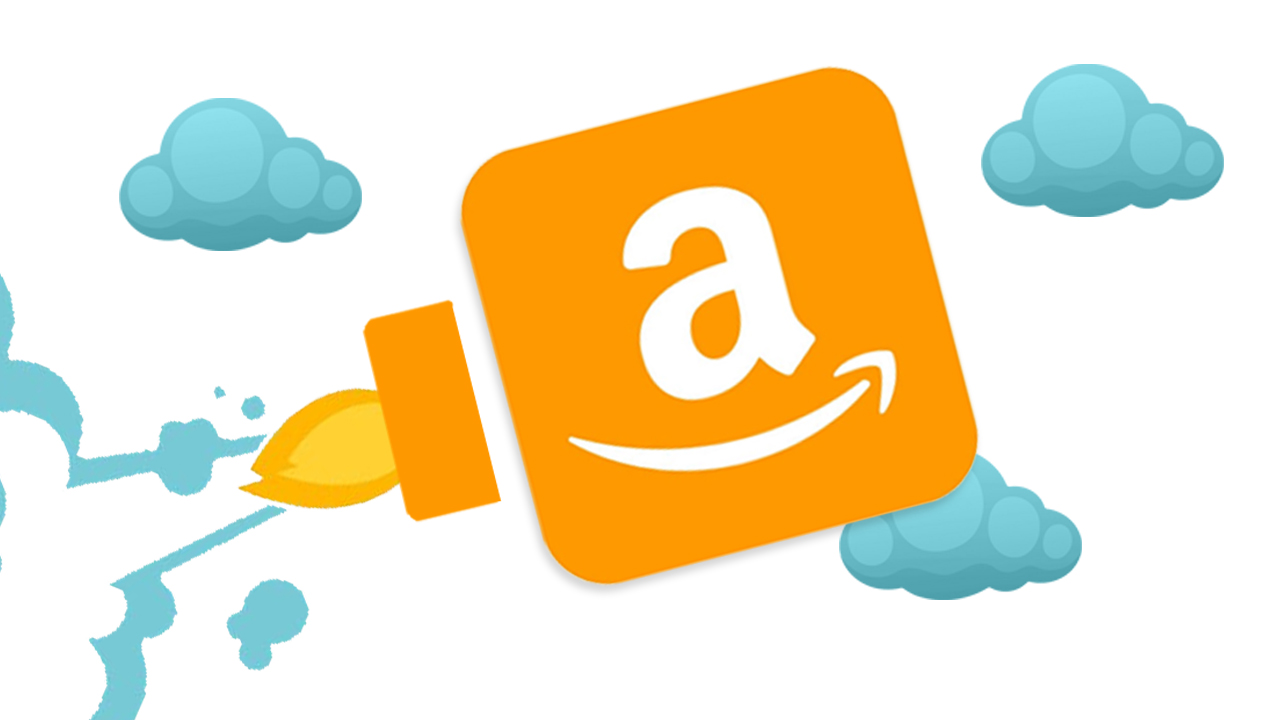
The journey from product idea to successful Amazon launch becomes infinitely more manageable. This happens when you leverage proven strategies and reliable resources. Throughout this guide, you’ve discovered four powerful methods for finding manufacturers. These range from the global reach of Alibaba to the domestic focus of ThomasNet. Additionally, they include the simplicity of Google search and the insider advantage of pre-vetted supplier databases. Each method offers unique benefits. Furthermore, combining them creates a comprehensive sourcing strategy. Consequently, this maximizes your options while minimizing risk.
More importantly, you now understand that finding manufacturers doesn’t require months of research. Similarly, it doesn’t require industry connections. Instead, it just requires systematic application of these straightforward techniques. The real success stories in Amazon FBA don’t come from people with special advantages. Rather, they come from ordinary individuals who take action. Additionally, they persist through challenges. Moreover, they leverage available resources intelligently. Notably, you possess everything necessary to join their ranks. Consequently, you can build your own profitable Amazon business.
The manufacturers you need are out there right now. Specifically, they’re ready and eager to partner with entrepreneurs like you. These are entrepreneurs who have great product ideas. Furthermore, they have the determination to bring them to market. Whether you’re developing a simple accessory or a complex customized product, suppliers exist who can execute your vision. Notably, they can do this at quality levels and price points that make business sense. Your job is simply to find them using these proven methods. Subsequently, evaluate them systematically. Finally, choose the partner who best aligns with your goals and values.
Take that crucial first step today. Begin your manufacturer search. Additionally, create your comparison spreadsheet. Moreover, reach out to potential suppliers. Join the wait list for the Passion Product Formula. Consequently, you’ll gain access to that game-changing manufacturer database. Furthermore, you’ll get comprehensive training that guides you through every step of the process. Alternatively, start with the free YouTube training if you prefer to dip your toes in gradually. Regardless of which path you choose, the key is choosing one and moving forward. Therefore, don’t remain stuck in analysis paralysis. Ultimately, your Amazon FBA success story begins with the action you take right now.
Frequently Asked Questions
How much does it typically cost to order samples from manufacturers?
Sample costs vary dramatically depending on your product complexity and customization requirements. Simple, generic products might cost just a few dollars per sample plus shipping. However, highly customized items can run $50-$200 or more for initial samples. Most manufacturers charge for samples to cover their costs. Additionally, this also ensures you’re serious. Notably, some may refund sample fees if you place a production order. Always factor sample expenses into your initial budget. Consequently, this investment proves essential for validating quality before committing to large orders.
What’s a reasonable minimum order quantity for a first-time Amazon seller?
Minimum order quantities range widely. Specifically, some manufacturers require as low as 50-100 units. Conversely, others require 5,000+ units or more. This depends on product type and supplier policies. For first-time sellers, aim for MOQs between 200-500 units if possible. Notably, this quantity allows you to test market demand. Furthermore, you won’t face excessive capital investment or inventory risk. However, balance MOQ considerations with per-unit pricing. Typically, larger orders offer significantly better margins. Calculate your total investment and potential returns at various quantities. Therefore, do this before deciding what makes sense for your specific situation.
Should I visit my manufacturer’s facility in person before placing orders?
Visiting manufacturer facilities provides tremendous value when feasible. This particularly applies for major commitments or ongoing partnerships. In-person visits allow you to assess operations. Moreover, you can meet team members. Additionally, you can verify equipment capabilities. Furthermore, you can build relationships that strengthen your working dynamic. However, international travel isn’t always practical or cost-effective. This particularly applies for initial orders. In these cases, video calls help mitigate risk. Additionally, comprehensive sample testing helps too. Similarly, starting with smaller orders is another option. For domestic manufacturers, facility visits become much more accessible. Consequently, they’re highly recommended when possible.
How long does the entire manufacturing process typically take from order to delivery?
Manufacturing timelines vary based on product complexity, order size, and current supplier workload. Typically, lead times range from 15-30 days for production plus shipping time. Simple products with existing tooling might complete faster. Conversely, customized items requiring new molds or specialized processes can take 45-60 days or longer. Shipping adds another 3-5 days for domestic delivery. Alternatively, ocean freight from overseas takes 2-4 weeks. Always build buffer time into your launch plans. Consequently, this accommodates potential delays, customs clearance, and quality inspection periods.
Can I negotiate pricing and terms with manufacturers, especially as a new seller?
Yes, most manufacturers expect negotiation. Furthermore, they build flexibility into their initial quotes. However, your leverage depends on order size, relationship stage, and market conditions. New sellers with small orders have less negotiating power. This differs from established partners placing regular large orders. That said, you can often negotiate better terms by committing to multiple orders. Additionally, accepting longer lead times helps. Similarly, simplifying packaging helps. Moreover, being flexible on specifications helps too. Approach negotiations collaboratively rather than aggressively. Therefore, seek win-win outcomes that work for both parties. Consequently, this lays foundations for long-term partnerships.
What payment terms should I expect when working with overseas manufacturers?
Standard payment terms for overseas manufacturing typically involve a 30% deposit upfront. Subsequently, you pay the 70% balance before shipping. This particularly applies for new relationships. Some suppliers may require full payment in advance. However, established relationships might evolve to more favorable terms. These include 50/50 splits or payment after production completion. Always use Trade Assurance on Alibaba when possible. Additionally, use escrow services to protect your funds. Wire transfers are standard for international transactions. Notably, some suppliers now accept PayPal or credit cards for smaller orders. Never pay through untraceable methods. Moreover, don’t deviate from the platform’s recommended payment processes.
How do I protect my product idea when talking to manufacturers?
While concerns about intellectual property theft are valid, the reality is different. Most manufacturers have no interest in stealing your product idea. Specifically, they profit from manufacturing, not product development and marketing. However, you can take protective steps. File provisional patents. Additionally, use non-disclosure agreements, though many manufacturers won’t sign them initially. Moreover, avoid sharing unnecessary details until you’ve vetted suppliers thoroughly. Focus on finding manufacturers with established reputations and long track records. Notably, they have more to lose from unethical behavior. Additionally, remember that successful products depend on many factors beyond just the idea itself. These include branding, marketing, and customer service. Consequently, manufacturers cannot easily replicate these.



